Cyclopropyl Alkyl Amines And Process For Their Preparation
HAN; Zhengxu ; et al.
U.S. patent application number 16/500876 was filed with the patent office on 2020-01-30 for cyclopropyl alkyl amines and process for their preparation. The applicant listed for this patent is Boehringer Ingelheim International GmbH. Invention is credited to Zhengxu HAN, Maurice A. MARSINI, Hao WU, Xingzhong ZENG.
| Application Number | 20200031753 16/500876 |
| Document ID | / |
| Family ID | 62002463 |
| Filed Date | 2020-01-30 |
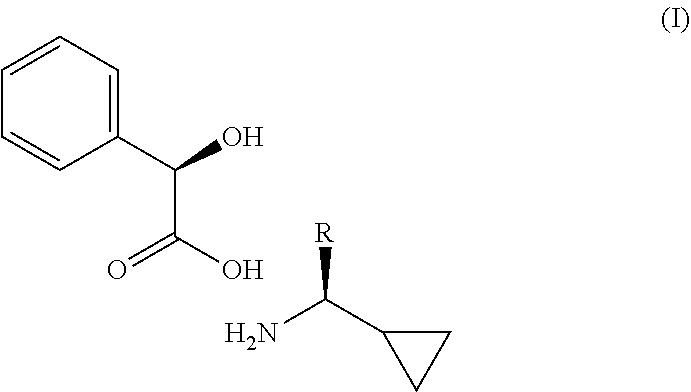

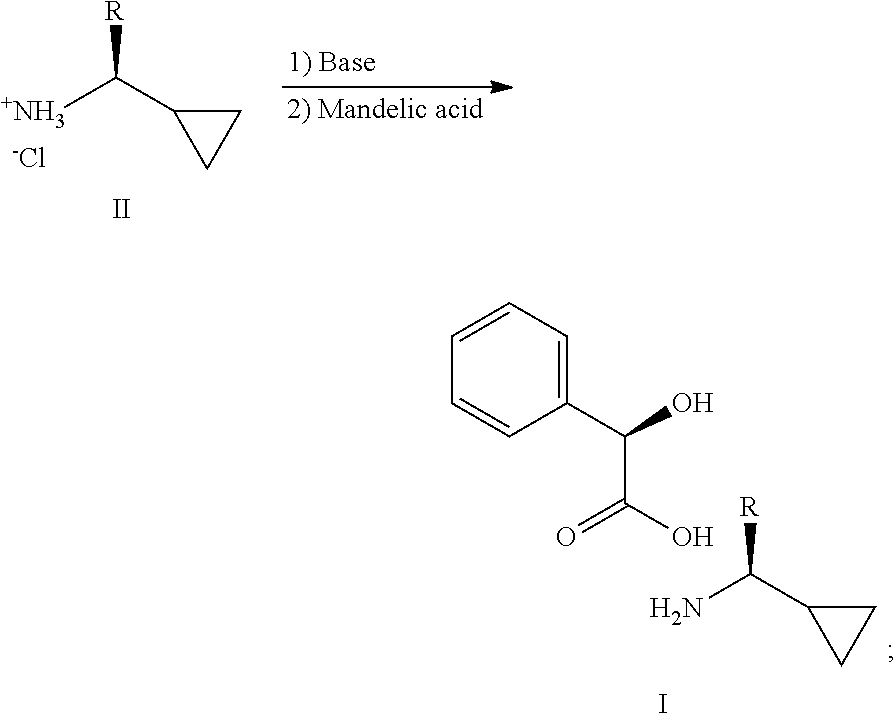
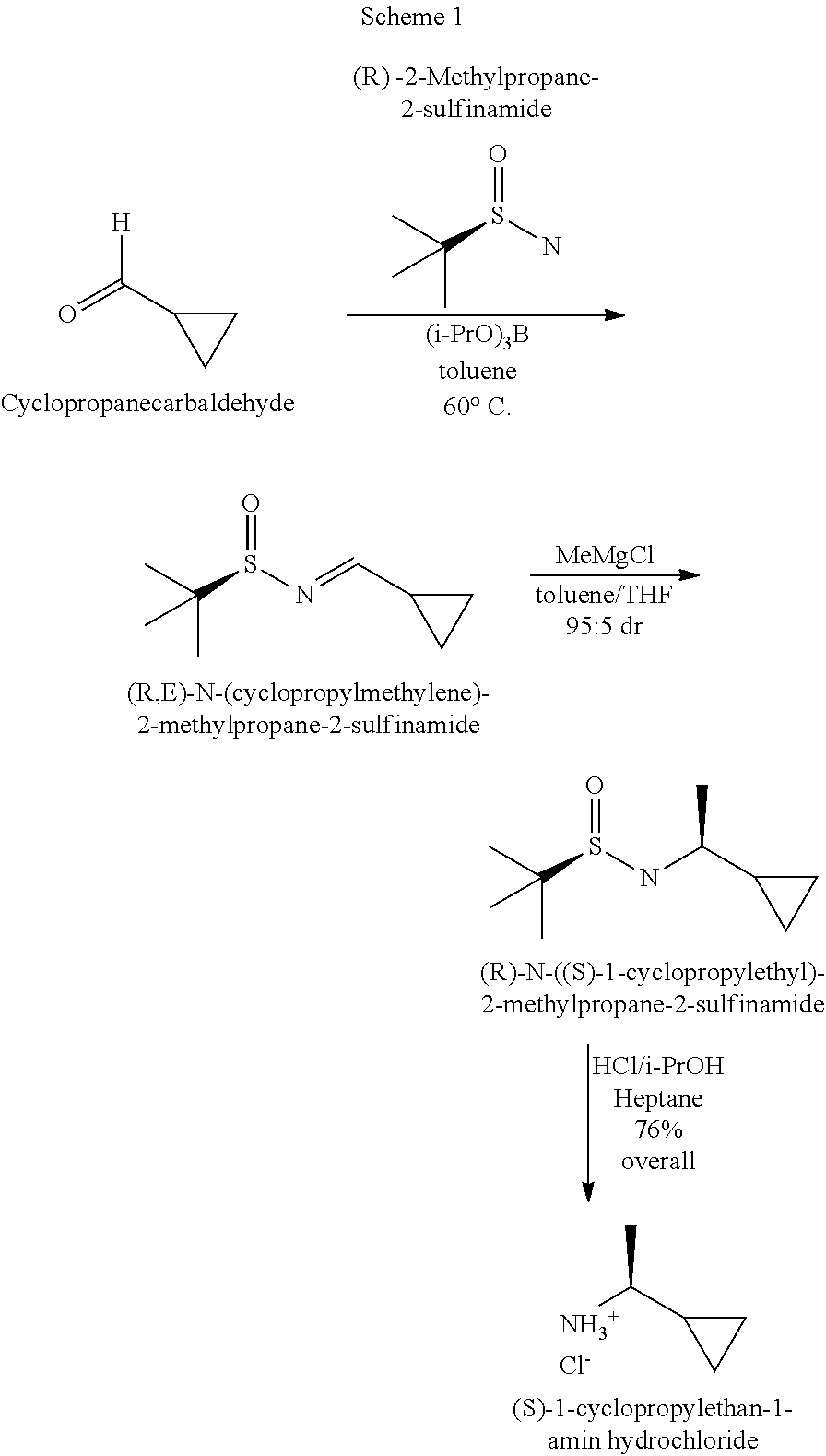

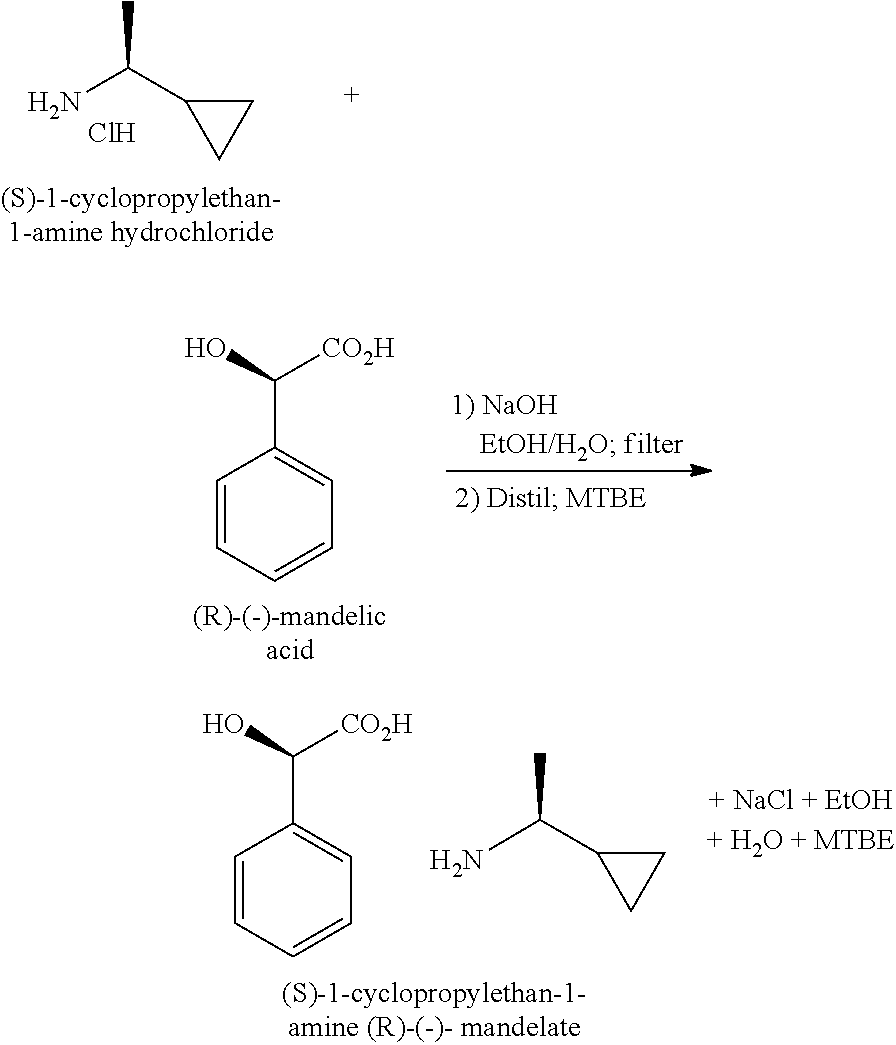
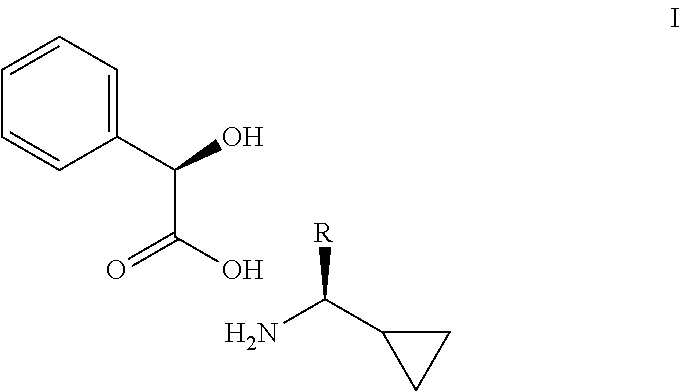
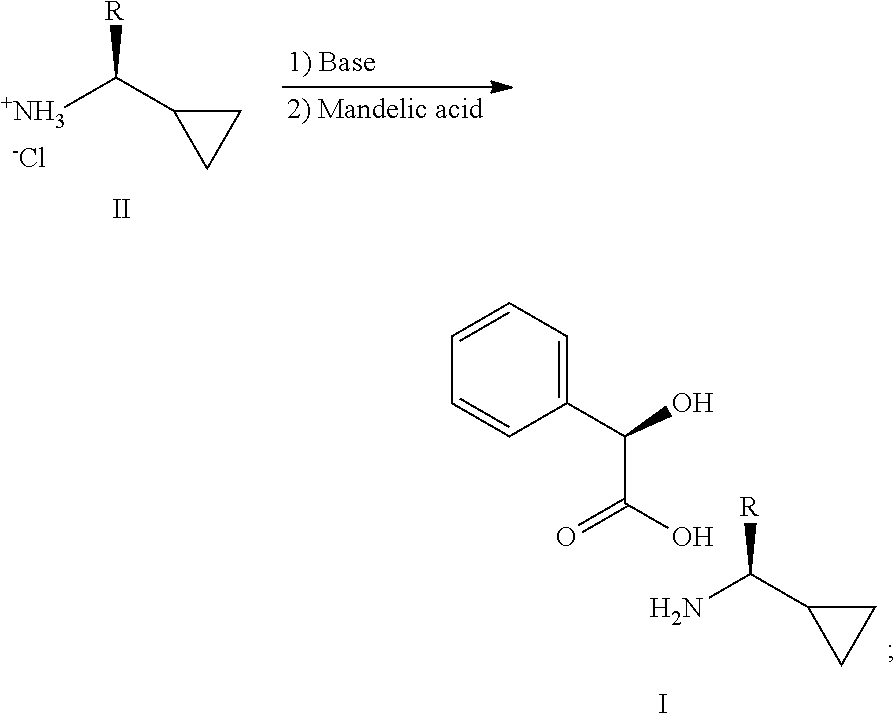
| United States Patent Application | 20200031753 |
| Kind Code | A1 |
| HAN; Zhengxu ; et al. | January 30, 2020 |
CYCLOPROPYL ALKYL AMINES AND PROCESS FOR THEIR PREPARATION
Abstract
The present invention relates to a process of making a compound of formula (I). Wherein, R is as defined herein. ##STR00001##
| Inventors: | HAN; Zhengxu; (Shrewsbury, MA) ; MARSINI; Maurice A.; (Danbury, CT) ; WU; Hao; (New Milford, CT) ; ZENG; Xingzhong; (New Milford, CT) | ||||||||||
| Applicant: |
|
||||||||||
|---|---|---|---|---|---|---|---|---|---|---|---|
| Family ID: | 62002463 | ||||||||||
| Appl. No.: | 16/500876 | ||||||||||
| Filed: | March 28, 2018 | ||||||||||
| PCT Filed: | March 28, 2018 | ||||||||||
| PCT NO: | PCT/US2018/025072 | ||||||||||
| 371 Date: | October 4, 2019 |
Related U.S. Patent Documents
| Application Number | Filing Date | Patent Number | ||
|---|---|---|---|---|
| 62482250 | Apr 6, 2017 | |||
| Current U.S. Class: | 1/1 |
| Current CPC Class: | C07C 211/17 20130101; C07C 51/412 20130101; C07B 2200/07 20130101; C07C 2601/02 20170501; C07C 59/50 20130101 |
| International Class: | C07C 51/41 20060101 C07C051/41 |
Claims
1. A compound having the following formula I: ##STR00007## wherein R is a C.sub.1-3 alkyl.
2. A process for making a compound of the formula I in claim 1, comprising reacting an amine of formula II with a suitable base and mandelic acid, in a suitable solvent, to provide a compound of formula I: ##STR00008## wherein R in formula I and II, is a C.sub.1-3 alkyl.
Description
[0001] This application relates to a method of resolution of 1-cyclopropyl alkyl-1-amines which are building blocks in the preparation of substituted pyrazinones. These substituted pyrazinones can be used to prepare pharmaceutically active compounds containing a substituted pyrazinone ring system.
BACKGROUND OF THE INVENTION
[0002] Cyclopropyl alkyl amines may be prepared by methods known in the literature and converted to substituted pyrazinones by adapting methods known in the literature. These substituted pyrazinone compounds can then be used to prepare pharmaceutically active compounds, such as ROR gamma modulators, containing a pyrazinone ring. These ROR gamma modulators are useful in treating a variety of diseases and disorders that are mediated through this pathway. The diseases that may be treated include but are limited to psoriasis and other inflammatory diseases. The preparation of ROR gamma modulators, containing a substituted pyrazinone ring, is disclosed in U.S. Pat. No. 9,242,989, issued Jan. 26, 2016, "Compounds as modulators of ROR gamma".
DESCRIPTION OF THE INVENTION
[0003] The present invention is directed to a process of making a compound of formula I
##STR00002##
[0004] the process comprising: reacting an amine of formula II with a suitable base and mandelic acid, in a suitable solvent, to provide a compound of formula I:
##STR00003##
[0005] Wherein R in formula I and II, is a C.sub.1-3 alkyl;
[0006] Non-limiting examples of bases useful in reaction step (1) include sodium hydroxide, potassium hydroxide, potassium t-butoxide, sodium t-butoxide, lithium t-butoxide, sodium hydride, potassium hydride, lithium hydride, sodium hexamethyldisilazide, potassium hexamethyldisilazide, lithium hexamethyldisilazide, sodium methoxide, potassium methoxide, lithium methoxide, sodium ethoxide, potassium ethoxide, lithium ethoxide, LDA, n-butyllithium, sec-butyllithium or t-butyllithium. Non-limiting examples of solvents useful for reaction step (1) include ethanol, methanol, propanol, water and mixtures thereof. Non-limiting examples of solvents useful for reaction step (2) include N,N-dimethylformamide, dichloromethane, ethyl acetate, hexane, heptane, acetonitrile, methyl tert-butyl ether, isopropyl acetate, toluene, and cyclopropylmethyl ether.
[0007] Starting amines of formula II may be prepared by methods known in the literature including (Lim et al., Discovery of 1-Amino-5H-pyrido[4,3-b]indol-4-carboxamide Inhibitors of Janus Kinase 2 (JAK2) for the Treatment of Myeloproliferative Disorders, J. Med. Chem., 2011, 54, 7334-7349), but not limited to the reaction sequence below:
##STR00004##
[0008] The mandelate salt of Formula (I) may be further transformed to Pyrazinone D, a key intermediate for the preparation of ROR gamma modulators, as shown below in Scheme 2 and disclosed in U.S. Pat. No. 9242989, issued Jan. 26, 2016, "Compounds as modulators of ROR gamma".
##STR00005##
[0009] As illustrated in Scheme 2, a suitable pyrimidine of formula A, wherein G is NH.sub.2, X is a suitable group for palladium-mediated cross coupling reactions (e.g., I, Br, Cl, or OSO.sub.2CF.sub.3), and Y is a suitable leaving group (e.g., Cl), may be reacted with a suitable amine or amine salt (e.g., hydrochloride salt) of formula R.sup.4NH.sub.2 such as isopropyl amine in the presence of a suitable base (e.g., i-Pr.sub.2EtN, or Et.sub.3N) in a suitable solvent (e.g., n-butanol) and under a suitable reaction conditions such as an appropriate temperature (e.g., about 120.degree. C.) to provide a compound of formula B. Alternatively, the said pyrimidine of formula A wherein G is a suitable synthetic precursor for NH.sub.2 (e.g., a nitro group) may be reacted with a suitable amine or amine salt (e.g., hydrochloride salt) of formula R.sup.4NH.sub.2 such as 1-methyl cyclopropylamine in the presence of a suitable reagent and solvent (e.g., i-Pr.sub.2EtN and THF, respectively), and under a suitable reaction conditions such as an appropriate temperature (e.g., about -78.degree. C. to about 25.degree. C.) to afford an intermediate, which may be converted to a compound of formula B upon further reaction with suitable reagents (e.g., a NO.sub.2 group that may be reduced with a suitable reagent such as SnCl.sub.2). The selection of a suitable amine of formula R.sup.4NH.sub.2 and pyrimidine of formula A for the aforementioned reaction by a person skilled in the art may be based on criteria such as steric and electronic nature of the amine and the pyrimidine. A diaminopyrimidine of formula B may be reacted with a suitable reagent such as chloro-oxo-acetic acid ethyl ester in a suitable solvent (e.g., acetone) and in the presence of a suitable base (e.g., K.sub.2CO.sub.3) to furnish a compound of formula C. A dicarbonyl compound of formula C' may be reacted with a suitable dehydrochlorinating reagent such as oxalyl chloride in the presence of a suitable additive (e.g., a catalytic amount of DMF) in a suitable solvent (e.g., CH.sub.2Cl.sub.2), and under a suitable reaction conditions such as an appropriate temperature (e.g., about ambient temperature) to provide a compound of formula D.
[0010] The invention relates to the use of any compounds described above containing one or more asymmetric carbon atoms including racemates and racemic mixtures, single enantiomers, diastereomeric mixtures and individual diastereomers. Isomers shall be defined as being enantiomers and diastereomers. All such isomeric forms of these compounds are expressly included in the present invention. Each stereogenic carbon may be in the R or S configuration, or a combination of configurations.
[0011] Some of the compounds of the invention can exist in more than one tautomeric form. The invention includes methods using all such tautomers.
[0012] All terms as used herein in this specification, unless otherwise stated, shall be understood in their ordinary meaning as known in the art. For example, "C.sub.1-6 alkoxy" is a C.sub.1-6 alkyl with a terminal oxygen, such as methoxy, ethoxy, propoxy, butoxy. All alkyl, alkenyl, and alkynyl groups shall be understood as being branched or unbranched where structurally possible and unless otherwise specified. Other more specific definitions are as follows:
[0013] The term "alkyl" refers to both branched and unbranched alkyl groups. It should be understood that any combination term using an "alk" or "alkyl" prefix refers to analogs according to the above definition of "alkyl". For example, terms such as "alkoxy", "alkythio" refer to alkyl groups linked to a second group via an oxygen or sulfur atom. "Alkanoyl" refers to an alkyl group linked to a carbonyl group (C.dbd.O).
[0014] In all alkyl groups or carbon chains, one or more carbon atoms can be optionally replaced by heteroatoms such as O, S, or N. It shall be understood that if N is not substituted then it is NH. It shall also be understood that the heteroatoms may replace either terminal carbon atoms or internal carbon atoms within a branched or unbranched carbon chain. Such groups can be substituted as herein above described by groups such as oxo to result in definitions such as but not limited to: alkoxycarbonyl, acyl, amido and thioxo. As used herein, "nitrogen" and "sulfur" include any oxidized form of nitrogen and sulfur and the quaternized form of any basic nitrogen. For example, for a --S--C.sub.1-6 alkyl radical, unless otherwise specified, shall be understood to include --S(O)--C.sub.1-6 alkyl and --S(O).sub.2--C.sub.1-6 alkyl.
[0015] The compounds of the invention are only those which are contemplated to be `chemically stable` as will be appreciated by those skilled in the art. For example, a compound which would have a `dangling valency`, or a `carbanion` are not compounds contemplated by the inventive methods disclosed herein.
[0016] General Synthetic Methods
[0017] The invention provides processes for making compounds of Formula (I). Optimum reaction conditions and reaction times may vary depending on the particular reactants used. Unless otherwise specified, solvents, temperatures, pressures, and other reaction conditions may be readily selected by one of ordinary skill in the art. Specific procedures are provided in the Synthetic Examples section. Typically, reaction progress may be monitored by thin layer chromatography (TLC) or LC-MS, if desired, and intermediates and products may be purified by chromatography on silica gel, recrystallization and/or preparative HPLC.
[0018] The example which follows is illustrative and, as recognized by one skilled in the art, particular reagents or conditions could be modified as needed for individual compounds without undue experimentation. Starting materials and intermediates used are either commercially available or easily prepared from commercially available materials by those skilled in the art.
SYNTHETIC EXAMPLE
Example 1
Synthesis of (S)-1-Cyclopropylethan-1-amine (R)-(-)-mandelate
##STR00006##
[0020] A solution of (S)-1-cyclopropylethan- 1-amine hydrochloride in ethanol (EtOH, 15 V) is treated with 1.0 eq of 25 wt % aqueous sodium hydroxide (NaOH) at 20-25.degree. C. After 1 h at 20-25.degree. C., the resulting slurry is filtered through Celite to remove sodium chloride (NaCl). To (R)-(-)-mandelic acid is added a solution of (S)-1-cyclopropylethan-1-amine hydrochloride) in ethanol, obtained above. EtOH/water is removed by azeotropic distillation to .about.4 V, after which methyl tert-butyl ether (MTBE, 12 V) is added at 60.degree. C. After controlled cooling, the batch is filtered, and the wetcake is washed with 1:3 EtOH/MTBE. The product is obtained as a white solid in .about.83-87% isolated yield with a GC purity of >99 A %, >95.sup.1H NMR wt %, and .about.99.5:0.5 er by GC analysis of the corresponding trifluoroacetamide derivative.
* * * * *








XML
uspto.report is an independent third-party trademark research tool that is not affiliated, endorsed, or sponsored by the United States Patent and Trademark Office (USPTO) or any other governmental organization. The information provided by uspto.report is based on publicly available data at the time of writing and is intended for informational purposes only.
While we strive to provide accurate and up-to-date information, we do not guarantee the accuracy, completeness, reliability, or suitability of the information displayed on this site. The use of this site is at your own risk. Any reliance you place on such information is therefore strictly at your own risk.
All official trademark data, including owner information, should be verified by visiting the official USPTO website at www.uspto.gov. This site is not intended to replace professional legal advice and should not be used as a substitute for consulting with a legal professional who is knowledgeable about trademark law.